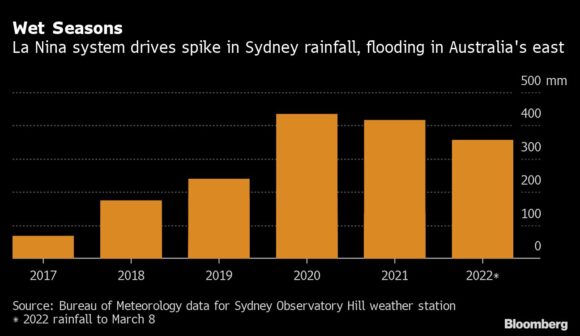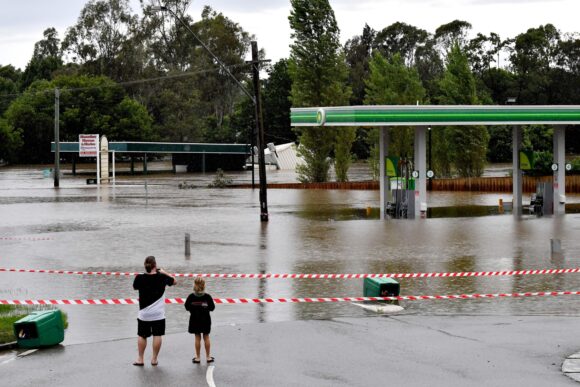Australia’s Prime Minister Scott Morrison conceded that a changing climate is making the country a more difficult place to live as he declared recent destructive flooding on the east coast a national emergency.
Morrison spoke to reporters as he visited Lismore, in northern New South Wales state, one of the areas worst hit by the natural disaster. Extreme rainfall and flooding has already claimed at least 20 lives across Queensland state and NSW and caused tens of thousands of residents to flee their homes since the downpours began about two weeks ago.
“Australia is becoming a harder country to live in because of these natural disasters,” Morrison told reporters on Wednesday, adding that the world was dealing with “a different climate to the one we were dealing with before.”
While the government has committed to net zero carbon emissions by 2050, it has been regularly criticized for taking inadequate action on climate change. Two La Nina seasons in 2021 and 2022 have led to unusually wet summers on Australia’s east coast, and forced a greater focus on climate ahead of a national election due to be held by the end of May.
The emergency declaration on Wednesday hands the government more powers to deploy aid and defense force personnel.
Australia is considered by many to be at vanguard of the impact of climate change — a position that’s become frighteningly clear in recent years. Torrential flooding episodes during wet years have been interspersed with blazing dry summers that have led to devastating wildfires, including the 2020 crisis that scorched an area of land almost the size of England.
In a statement on Monday, Australia’s Climate Council advocacy group said scientists had been warning “for decades” of the dangers from extreme weather caused by carbon emissions.
“Climate change isn’t a footnote to the story of these floods. It is the story,” the council said in the statement.
Morrison has pledged to cut Australia’s emissions by up to 28% by 2030, but an Essential poll in November 2021 found Australians trusted the opposition Labor Party more to handle the issue of climate change than the government, by a margin of 39% to 26%.

When pressed on whether his government had done enough to address climate change, Morrison on Wednesday defended his policies, saying Australia was working with other countries to develop carbon reduction technologies and claiming there had been a 20% fall in emissions. “I’ll tell you what’s not going to fix climate change, what’s not going to fix it is just doing something in Australia,” he said.
Residents in parts of New South Wales state, including in greater Sydney’s wealthy northern beaches suburbs, were forced to evacuate on Tuesday afternoon as roads were cut off and amid concern about a dam overflowing.
There have been almost 100,000 claims to insurers as a result of the floods in NSW and Queensland, according to the Insurance Council of Australia, 80% of which were for domestic property. In NSW, there has been an increase of 12% in the past 24 hours. The estimated current cost of claims is now A$1.45 billion ($1.1 billion), the council said, based on the numbers from previous flood events.
The floods, combined with Russia’s invasion of Ukraine, led Australia’s consumer sentiment to plunge in March, falling 4.2% to 96.6 point according to Westpac Banking Corp., the weakest result since September 2020.
Higher prices for food and bare supermarket shelves are set to become more frequent occurrences in Australia, as an increasingly volatile climate threatens supply chains and the availability of vital inputs including insurance, finance and fertilizer, according to a Wednesday report from environmental lobby group Farmers for Climate Action.
Potential for flooding to occur in the NWestrn parts of NSW, including #Mungindi to #Collarenebri as floodwater travels down river systems from QLD into NSW. We are monitoring this situation and planning for the impacts of potential flooding in these areas https://t.co/R65UsEnnoi pic.twitter.com/qqF9yo1Z4L
— NSW SES (@NSWSES) March 9, 2022
Photograph: A petrol station inundated by the floodwater in southwestern suburb of Camden in Sydney on March 8. Photo credit: Muhammad Farooq/AFP/Getty Images.
Topics Australia Climate Change
Was this article valuable?
Here are more articles you may enjoy.



 New York Governor Hochul Vows to Tackle Insurance Affordability, Litigation and Fraud
New York Governor Hochul Vows to Tackle Insurance Affordability, Litigation and Fraud  Supreme Court Rejects Challenge to $2.46B Boy Scouts Sex Abuse Settlement
Supreme Court Rejects Challenge to $2.46B Boy Scouts Sex Abuse Settlement  Expense Ratio Analysis: AI, Remote Work Drive Better P/C Insurer Results
Expense Ratio Analysis: AI, Remote Work Drive Better P/C Insurer Results  Wildfires, Storms Fuel 2025 Insured Losses of $108 Billion: Munich Re Report
Wildfires, Storms Fuel 2025 Insured Losses of $108 Billion: Munich Re Report 

